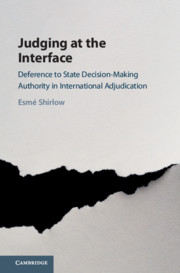Book contents
- Judging at the Interface
- Judging at the Interface
- Copyright page
- Dedication
- Contents
- Figures
- Tables
- Foreword by Judge James Crawford
- Acknowledgements
- Table of Cases
- Table of Treaties, Resolutions, and Declarations
- Abbreviations
- Introduction Deference and the International Adjudication of Private Property Disputes
- Part I Conceptual Framework and Methodological Approach
- Part II Deference in the International Adjudication of Private Property Disputes
- Part III The Systemic Role of Deference in International Law
- 8 Deference in Different Times and Contexts
- 9 The Systemic Implications of Deference in International Adjudication
- 10 Bringing Principles into Practice: Grappling with Deference in International Adjudication
- Conclusion Deference as a Story of International Law and Adjudication
- Appendix Data Tables
- References
- Index
10 - Bringing Principles into Practice: Grappling with Deference in International Adjudication
from Part III - The Systemic Role of Deference in International Law
Published online by Cambridge University Press: 24 February 2021
- Judging at the Interface
- Judging at the Interface
- Copyright page
- Dedication
- Contents
- Figures
- Tables
- Foreword by Judge James Crawford
- Acknowledgements
- Table of Cases
- Table of Treaties, Resolutions, and Declarations
- Abbreviations
- Introduction Deference and the International Adjudication of Private Property Disputes
- Part I Conceptual Framework and Methodological Approach
- Part II Deference in the International Adjudication of Private Property Disputes
- Part III The Systemic Role of Deference in International Law
- 8 Deference in Different Times and Contexts
- 9 The Systemic Implications of Deference in International Adjudication
- 10 Bringing Principles into Practice: Grappling with Deference in International Adjudication
- Conclusion Deference as a Story of International Law and Adjudication
- Appendix Data Tables
- References
- Index
Summary
This chapter draws together the preceding conceptual and empirical analysis of deference in international adjudication to explore how the principles discussed in the preceding pages might be used to inform approaches to deference in practice. This chapter does not develop a prescriptive approach to deference in international adjudication. It instead offers a framework to inform the analysis of deference in international adjudication. Section 10.1 addresses debates as to whether international adjudicative deference to domestic decision makers is desirable at all. Section 10.2 examines whether approaches to deference should be ‘fixed’ in favour of some doctrinal approaches over others. Section 10.3 explores how a framework for analysing deference might be created, which allows evolution and malleability in approaches to deference while securing some level of predictability and transparency in practice. Section 10.4 concludes.
Keywords
- Type
- Chapter
- Information
- Judging at the InterfaceDeference to State Decision-Making Authority in International Adjudication, pp. 239 - 267Publisher: Cambridge University PressPrint publication year: 2021

